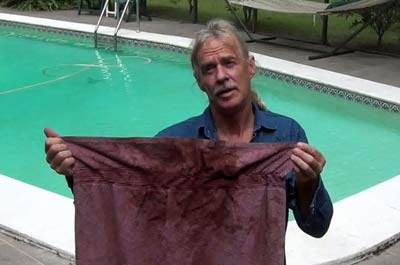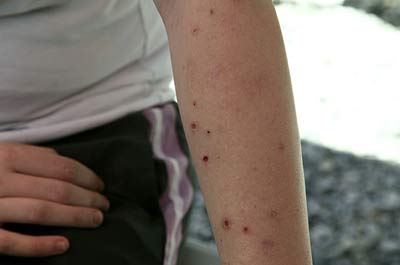
New Orleans – Peter Frizzell never thought his watersports off the coast of Florida would destroy his health.
“After sea kayaking after BP’s spill happened, I was sitting at my desk and started coughing up loads of blood,” Frizzell, an avid outdoorsman, told Al Jazeera. “My doctor ran a scope down to the top of my lungs and said my bronchi were full of blood.”
Frizzell’s medical records bear out that he was exposed to toxic chemicals, and he is far from alone.
Since the spill began in April 2010, Al Jazeera has interviewed hundreds of coastal residents, fishermen, and oil cleanup workers whose medical records, like Frizzell’s, document toxic chemical exposure that they blame on BP’s oil and the toxic chemical dispersants the oil giant used on the spill.
The US Center for Disease Control and Prevention lists the toxic components commonly found in chemicals in crude oil, and several of these chemicals have been found in the blood of people living in the impact zone of BP’s disaster.
Several toxicologists agree, and now one accuses both BP and the US Environmental Protection Agency of knowingly placing people in harm’s way since they both had prior knowledge of the harmful effects of the oil and dispersants.
“BP told the public that Corexit was ‘as harmless as Dawn dishwashing liquid’,” Dr Susan Shaw, of the State University of New York, told Al Jazeera. “But BP and the EPA clearly knew about the toxicity of the Corexit dispersants long before this spill.”
Shaw, a toxicologist in the university’s School of Public Health, has been studying the health effects of chemical exposure for 30 years. She is also the president and founder of the Marine Environmental Research Institute, and explained that BP’s Material Safety Data Sheets for Corexit warned that the dispersant posed high and immediate human health hazards.
“Five of the Corexit ingredients are linked to cancer, 33 are associated with skin irritation from rashes to burns, 33 are linked to eye irritation, 11 are or are suspected of being potential respiratory toxins or irritants, and 10 are suspected kidney toxins,” she added. “BP’s own testing found that workers were exposed to a possible human carcinogen from the dispersant.
“We predicted with certainty the widespread human health crisis we are seeing in the Gulf today,” Shaw said.
Hazardous to Human Health
A newly published study conducted by doctors at Houston’s University Cancer and Diagnostic Centers and reported in the American Journal of Medicine, sheds more light on the potential health repercussions for the more than 170,000 people who worked in some capacity to clean up the 2010 disaster.
Their blood tests suggest an elevated health risk for Gulf spill cleanup workers. The study shows that people hired to clean up Gulf of Mexico beaches and marshes during the 2010 oil spill have significantly altered blood profiles that, just as Shaw and other toxicologists warned, put them at increased risk of developing liver cancer, leukemia and other disorders.
“People in the Gulf were exposed to massive amounts of crude oil and Corexit dispersants, both of which contain multiple toxic chemicals, including volatile organic compounds and carcinogens that are hazardous to human health,” said Shaw, who served on the Department of Interior’s Strategic Sciences Working Group – a team of 14 scientists charged with assessing consequences of the oil spill and recommending policy actions in the Gulf.
“The combination of crude oil and Corexit is exponentially more toxic than either alone, since they contain many ingredients that target the same organs in the body.”
Dr. Riki Ott, a toxicologist, marine biologist, and Exxon Valdez survivor, told Al Jazeera she sees clear indications of widespread toxic chemical exposure across the four-state impact zone of BP’s oil disaster.
“It’s pretty clear to me, after spending a year in the Gulf coastal communities during 2010 and 2011, that the suite of illnesses that developed during this time were above and beyond the background level of illnesses incurred in the Gulf,” Ott said.
“People across four states expressed concern that these headache-dizziness-nausea-respiratory problems-blood disorders-skin lesions were different than anything they’d experienced before, and far more intense.”
Ott said that people she is seeing along the roughly 900km impact zone are all consistently describing these same symptoms of exposure to chemicals in the oil and dispersants.
 Skin lesions like this have become common in the impact zone of BP’s 2010 oil disaster in the Gulf of Mexico. (Photo: Erika Blumenfeld / Al Jazeera)“Medical literature supports that these are the symptoms, and I would expect to see increased rates of early term miscarriages for women, early developmental issues for children born to women who were exposed to breathing these fumes and vapours, and also continuing chemical hypersensitivity.”
Skin lesions like this have become common in the impact zone of BP’s 2010 oil disaster in the Gulf of Mexico. (Photo: Erika Blumenfeld / Al Jazeera)“Medical literature supports that these are the symptoms, and I would expect to see increased rates of early term miscarriages for women, early developmental issues for children born to women who were exposed to breathing these fumes and vapours, and also continuing chemical hypersensitivity.”
Unfortunately, what Ott describes is precisely what many Gulf residents are experiencing.
“We’re seeing spontaneous miscarriages, and cancer is rampant,” Trisha Springstead, a nurse of 36 years in Crystal River, Florida, told Al Jazeera. “These are occurring in Orange Beach, Alabama, and all over Mississippi and Alabama…women are not carrying to term.”
Dean Blanchard, owner of Dean Blanchard Seafood in Grand Isle, Louisiana, told Al Jazeera he knows many fishermen who participated in the oil clean-up operation who have since died.
“I’ve never seen anything like this in my life,” Blanchard said. “I know more than half a dozen guys who were totally healthy before the spill who worked on the clean up. They found out they got cancer and within one or two months were dead.”
Dr. Wilma Subra, a McArthur Fellow Genius Award-winning toxicologist in New Iberia, Louisiana, has tested the blood of BP clean-up workers and residents.
“Ethylbenzene, m,p-Xylene and hexane are volatile organic chemicals that are present in the BP crude oil,” Dr. Subra recently explained to Al Jazeera. “Exposure has been prolonged enough to create long-term effects, such as liver damage, kidney damage, and damage to the nervous system. So the presence of these chemicals in the blood indicates exposure.”
Ongoing Problems
According to Dr. Shaw, thousands of people in the Gulf – clean-up workers, fishermen, residents – have now reported multiple severe symptoms related to chemical exposure from the spill.
“What ties them together as a group is their spill-related health problems, which are also typical of the health problems reported from previous oil spills,” she said. “Some of these include: blood in urine, heart palpitations, kidney damage, liver damage, migraines, multiple chemical sensitivity, neurological damage, memory loss, rapid weight loss, respiratory system damage, skin lesions, muscle spasms, seizures, and temporary paralysis.”
Frizzell is experiencing many of these symptoms.
“I have neuropathy, my lungs are destroyed, I can’t feel my feet and legs at times,” he explained. “I still have skin lesions come up. How crazy is that that, out of nowhere, your lungs just explode. The day after I was exposed I soaked two full-sized bath towels with coughing up blood. That’s an indication of how much blood I was losing.”
Crude oil contains hundreds of toxic and carcinogenic ingredients, including volatile benzene and polyaromatic hydrocarbons. Benzene, a principal component of oil, is a human carcinogen that causes nerve damage, leukemia and other haematological cancers.“I have neuropathy, my lungs are destroyed, I can’t feel my feet and legs at times,” he explained. “I still have skin lesions come up. How crazy is that that, out of nowhere, your lungs just explode. The day after I was exposed I soaked two full-sized bath towels with coughing up blood. That’s an indication of how much blood I was losing.”
Official Response
Al Jazeera asked Louisiana Governor Bobby Jindal what his state was doing to safeguard people against chemical poisoning.
In an earlier statement to Al Jazeera, Jindal’s office said: “Coastal residents and response workers will be compensated through the deal reached between the Plaintiff Steering Committee and BP. BP must follow through on making whole [properly compensating] impacted residents and workers who experienced or are still experiencing health impacts as a result of the spill.”
At time of publishing, Al Jazeera continues to await an updated response from Jindal’s office.
Testimony in the second phase of the BP trial has just come to a close, and the penalty phase against BP has now begun, which is likely to take months. Litigators expect many of the personal claims filed against the oil giant to continue to take years.
Under a settlement with BP, clean-up workers are entitled to some medical payments for certain ailments that they can prove were tied to the spill-related work and their exposure.
BP stressed that workers received safety training and personal protective equipment in coordination with government safety agencies.
Denying Toxicity
“Based on extensive monitoring conducted by BP and the federal agencies, response worker and or public exposures to dispersants were well below levels that would pose a health or safety concern,” the company said.
“To deny the toxicity, BP deliberately put 170,000 workers in harm’s way,” Dr Shaw said of BP’s response. “BP told clean-up crews on the boats not to wear respirators because it made them look bad to reporters. A proper protective response would have been hazmat-style suits for anyone coming in contact with Corexit and oil.”
He became violently ill, began bleeding from his nose and ears, and began vomiting blood. When Yerkes couldn’t get well, he had his blood tested and found it contained high levels of chemicals which his physician attributed to BP’s oil disaster.
Following the advice of his attending physician, Yerkes was forced to move away from the Gulf.
“I have spent the last three years literally trying to survive,” Yerkes, who now must use a cane to walk and regularly gives himself intravenous treatments, told Al Jazeera. “I have chronic headaches, a fever, and suffer chronic unbearable pain in my muscles and joints, and have had chemical pneumonia twice so far.”
Dr. Ott is critical of how the US federal government has reacted to the health crisis.
“It is irresponsible at best, and disingenuous at worst for the federal government to pretend that people can be exposed to these chemicals and not connect the dots between these illnesses and what made them sick,” she said.
Dr. Ott is particularly troubled because she has seen all this before.
For years after the 1989 Exxon Valdez oil spill in Alaska, she watched as her friends suffered from the same symptoms of chemical exposure she sees today in the Gulf of Mexico.
“I saw many of them adjust to living being chemically ill, then on the other end of the spectrum, unfortunately, I’ve lost a lot of friends through this – because some people just died,” she added.
Dr. Ott explained that chemical illness is a debilitating condition, and believes that now in BP’s impact zone, chemical illness is neither being diagnosed nor treated.
She concluded: “In the Gulf, there is a blanket denial that this is happening at all.”
Join us in defending the truth before it’s too late
The future of independent journalism is uncertain, and the consequences of losing it are too grave to ignore. To ensure Truthout remains safe, strong, and free, we need to raise $27,000 in the next 24 hours. Every dollar raised goes directly toward the costs of producing news you can trust.
Please give what you can — because by supporting us with a tax-deductible donation, you’re not just preserving a source of news, you’re helping to safeguard what’s left of our democracy.